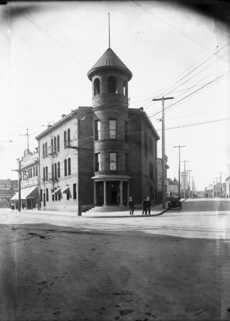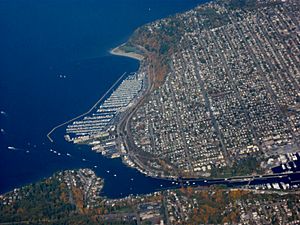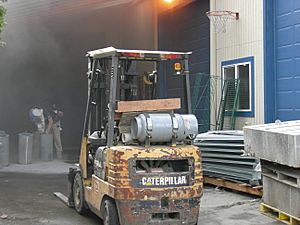Ballard, Seattle facts for kids
Quick facts for kids
Ballard
|
|
|---|---|
|
Seattle Neighborhood
|
|
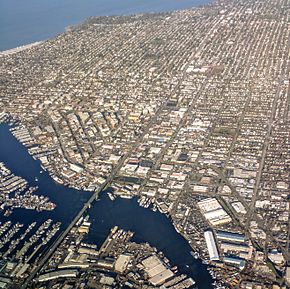
Aerial view of Ballard and Lake Washington Ship Canal from the south
|
|
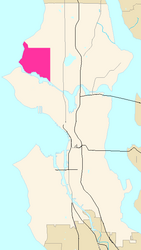
Map of Ballard's location in Seattle
|
|
| Country | United States |
| State | Washington |
| City | Seattle |
| Time zone | UTC-8 (Pacific Time) |
| • Summer (DST) | UTC-7 (Pacific Daylight Time) |
Ballard is a lively neighborhood in the northwest part of Seattle, Washington, United States. It used to be its own city! Today, Seattle's official maps show Ballard bordered by Crown Hill to the north, Greenwood, Phinney Ridge, and Fremont to the east. To the south, it's bordered by the Lake Washington Ship Canal, and to the west by Puget Sound's Shilshole Bay.
Some famous spots in Ballard include the Ballard Locks, the National Nordic Museum, Shilshole Bay Marina, and Golden Gardens Park. Important roads that run north-south are Seaview, 32nd, 24th, Leary, 15th, and 8th Avenues N.W. Roads going east-west include N.W. Leary Way and N.W. 85th, 80th, 65th, and Market Streets. The Ballard Bridge helps 15th Avenue cross Salmon Bay to the Interbay neighborhood. Also, the Salmon Bay Bridge carries BNSF Railway tracks over the bay, just west of the Ballard Locks.
Ballard is part of Seattle City Council District 6. It's also part of the Seattle Public Schools system.
Contents
Ballard's Past: A Journey Through Time
How Ballard Began: Early Days and First Settlers
The land where Ballard is now was first settled by the Dxʷdəwʔabš (Duwamish) Tribe after the last ice age. This area was perfect for them because it had lots of salmon and clams. A settlement near Shilshole Bay has been found by archaeologists. Its ancient tools and items are now kept at the Burke Museum. The last known member of the native group from Shilshole, called HWelch’teed or "Salmon Bay Charlie," was moved from the area around 1915. This happened so the Hiram Chittenden Locks could be built.
The first European settler, Ira Wilcox Utter, arrived in 1853. He later sold his land to Judge Thomas Burke. Years later, Judge Burke, with John Leary and Daniel H. Gilman, started a company to develop Burke's land. They expected the Great Northern Railway to be built along Salmon Bay.
Captain William Rankin Ballard owned land next to Judge Burke's. He joined the group, but later, after a coin toss, he ended up with the land in Salmon Bay. This land was thought to be "undesirable" at the time.
The railroad from Seattle stopped at Salmon Bay because building a bridge across the bay was too difficult. Passengers had to walk across a wagon bridge to continue their trip to Seattle. This stop, called "Ballard Junction," helped the new town grow. The railroad made it easier to bring supplies in and send local products out. This led to many mills being built. Ballard's first mill, a lumber mill, was built in 1888. A shingle mill followed the same year. After the Great Seattle Fire in 1889, many people moved to Ballard to work in these mills. Many Scandinavian immigrants came to Ballard during this time. Their culture became a big part of the neighborhood.
Ballard Becomes a City
As more people moved to Ballard, residents realized they needed a formal government. In November 1889, they voted to become an official town. Charles F. Treat became Ballard's first mayor. A count showed that the new town had over 1,500 residents. This made it the first "third-class town" in the new state of Washington.
By 1900, Ballard's population grew to 4,568. This made it the seventh-largest city in Washington. But the town faced many problems. One big issue was loose livestock. The "Cow Ordinance of 1903" made it illegal for cows to graze south of what is now 65th Street. More serious problems were the lack of clean water and a proper sewer system. Ballard got its water from local wells. But without good sewers, the groundwater became dirty, making the problem worse.
The town kept growing, reaching 17,000 residents by 1907. It became the second-largest city in King County. However, Ballard still struggled with its water problems. The fast growth meant the city couldn't provide enough services, especially safe drinking water and sewers. Ballard's government tried to fix these problems but couldn't. This made citizens think about asking Seattle to take over the town.
In 1905, residents voted against joining Seattle. They hoped things would get better. But the problems didn't go away. In 1906, a court ruled that Seattle couldn't provide water to nearby towns. Ballard had relied on Seattle for water, so this decision left them without enough. This forced a second vote on joining Seattle. By then, most residents realized their city couldn't handle the situation alone. They voted to join Seattle. On May 29, 1907, Ballard officially became part of Seattle. People in Ballard had mixed feelings. They draped their city hall with black cloth and flew the flag at half-mast to show their sadness.
Ballard Today: Growth and Change
In the early 1900s, Ballard was known for shipbuilding. The Ballard shipbuilding company built ships for the US Navy during World War II. They also built ships for everyday use. The area also had many fishing businesses and canneries. These marine industries were very important to Ballard's economy for most of the 20th century.
Towards the end of the 1900s, Ballard started to see a lot of new buildings. By 2007, many new apartment and shop buildings were being built or had just finished. This growth was part of a plan by former Seattle Mayor Norm Rice. His plan aimed to reduce the spread of cities by focusing new development in certain areas like Ballard.
Over the years, Ballard has added many places for live music, including bars, restaurants, and coffee shops. The Ballard Chamber of Commerce holds a "Second Saturday Artwalk" each month. Downtown Ballard is also home to the Majestic Bay Theater. This theater was once the oldest movie theater still running on the West Coast. It closed in 1997 but was renovated in 1998 into a modern three-screen theater.
Ballard Historical Society: Keeping History Alive
The Ballard Historical Society is a group of volunteers who work to preserve Ballard's history. They don't have a museum building. Instead, they share history through self-guided tours, historical markers on buildings, talks, and community events. The society collects old photos, documents, and items related to Ballard's past. Many of their old photos are available to see online.
The society started in 1988. In 2007, they put up Historic Markers on buildings in the Ballard Avenue Historic District. These markers tell you about the history of the buildings.
The organization also helped create a book called Voices of Ballard: Immigrant Stories from the Vanishing Generation (2001). This book shares stories from older Ballard residents who moved to the neighborhood before the 1960s. The Ballard Walking Tour is a self-guided tour created by the society. It points out 20 different historic places on and around Ballard Avenue. Every three years, the society organizes the Ballard Classic Homes Tour. This tour lets people see different old homes in Ballard.
Ballard's Unique Culture and Traditions
Ballard is famous for its strong connection to Scandinavian seafaring culture. Many people from Scandinavia came here because of the good salmon fishing. The neighborhood's unofficial saying, "Uff da," comes from a TV show sketch that made fun of its Scandinavian roots. Even though fewer Scandinavian residents live here now, the neighborhood is still very proud of its heritage.
Ballard is home to the National Nordic Museum. This museum celebrates Ballard's community and its Scandinavian history. Scandinavian groups like the Sons of Norway Leif Ericson Lodge and the Norwegian Ladies Chorus of Seattle are active here. Every year, the community celebrates the Ballard SeafoodFest. They also celebrate Norwegian Constitution Day (called Syttende Mai) on May 17. This day remembers when Norway signed its constitution.
The neighborhood also has a semi-professional soccer team called Ballard FC. It started in 2022 and plays in the USL League 2.
Schools and Libraries in Ballard
The public schools in Ballard are part of the Seattle Public Schools district. Ballard High School is located in the neighborhood. It is the oldest high school in the city that has been open continuously. The old building was taken down in the late 1990s. The new school building is now one of the largest in the district. It has a special biotechnology program that attracts students from all over Seattle.
There are several elementary schools and one alternative school in Ballard. The closest middle school is Whitman Middle School, which is north of Ballard.
- Adams Elementary School (Kindergarten-5th grade)
- Loyal Heights Elementary School (Kindergarten-5th grade)
- Matheia School (Kindergarten-5th grade, private)
- North Beach Elementary School (Kindergarten-5th grade)
- Salmon Bay School (Kindergarten-8th grade)
- St. Alphonsus School (Kindergarten-8th grade, Catholic)
- West Woodland Elementary School (Kindergarten-5th grade)
- Whittier Elementary School (Kindergarten-5th grade)
The Ballard Public Library first opened in 1904 as the Carnegie Free Public Library. After Ballard joined Seattle in 1907, the library became part of the Seattle Public Library system. The original Carnegie building on Market Street was replaced in 1963. In 2005, a new library building opened on 22nd Avenue NW. This was part of Seattle Public Library's "Libraries for All" project. The original Carnegie building on Market Street is now a restaurant.
The Seattle Metaphysical Library, which started in 1961, is now on Market Street in Ballard. It is open to the public and lends books to members.
Historic Places in Ballard
The following buildings, areas, and landmarks in Ballard are listed on the National Register of Historic Places. This means they are important historical sites.
 |
Ballard Avenue Historic District | This area is along Ballard Avenue N.W. between N.W. Market Street and N.W. Dock Place. It was added to the list in 1976. |
 |
Ballard Carnegie Library | This building is on N.W. Market Street. It was added to the list in 1979. |
 |
Fire Station No. 18 | This fire station is at the corner of Russell Avenue N.W. and N.W. Market. It was added in 1973. |
 |
Ballard Bridge | This bridge was added to the list in 1982. |
 |
Hiram M. Chittenden Locks and the Lake Washington Ship Canal | These important waterways were added to the list in 1978. |
Famous People from Ballard
Here are some notable people who have lived in Ballard:
- James Acord – a sculpture artist
- Josh Barnett – a UFC fighter
- Carl Deuker – a young adult sports author
- Tom Douglas – a famous chef and restaurant owner
- Jerry Holkins - a writer
- Edith Macefield – known for refusing to sell her house for development
- Dori Monson – a radio personality
- Karsten Solheim (1911–2000) – the person who started PING golf clubs


